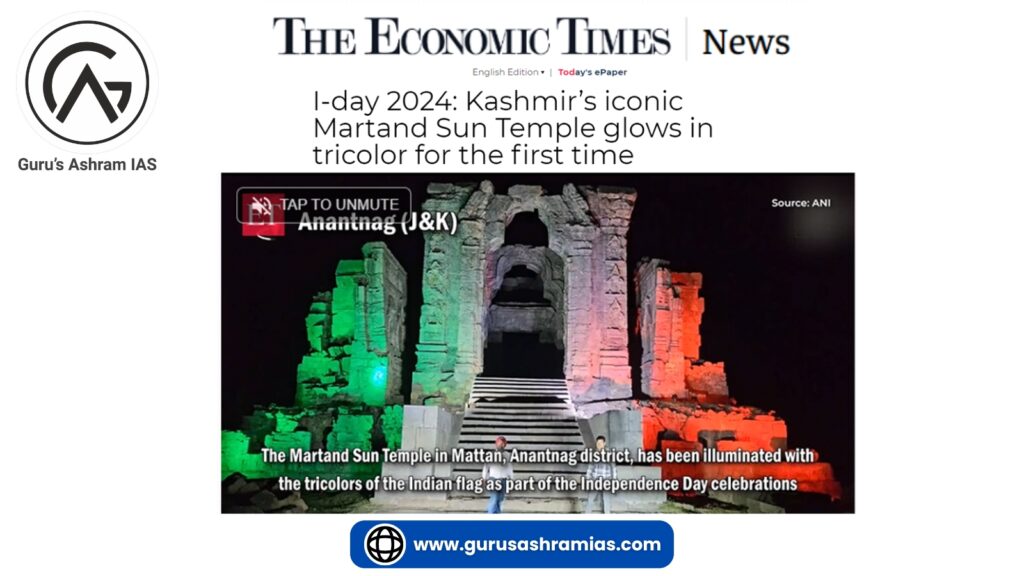Martand Sun Temple
- The Martand Sun Temple in Anantnag district of Jammu and Kashmir lit up in the three colours of the Indian flag to mark the Independence Day celebrations.
- This decoration has generated a sense of pride and joy among both locals and tourists, attracting many people to this historic event.
Martand Sun Temple:
- Martand Temple was built about 1200 years ago by King Lalitaditya Muktapid of Karkot dynasty, who ruled Kashmir from 725 AD to 753 AD.
- This temple was dedicated to the sun god Martand and its architecture shows the influence of Egyptian, Greek and Gandhara styles.
- The walls of the temple were made of large grey stones and its courtyard was filled with river water, which symbolizes its grandeur and importance in Kashmiri architecture.
Historical context:
- The history of the temple is described in the Rajatarangini written by Kalhana in the 12th century.
Architectural features:
- The temple had three distinct chambers namely the mandapa, the sanctum sanctorum and the antarala, making it unique among the diverse temples of Kashmir.
- The ruins show that the temple was surrounded by a group of 84 pillars, which is a feature of Kashmiri temple architecture.
- Unusually for the time, lime mortar was used in construction, indicating the involvement of immigrant Byzantine architects.
Cultural Inclusion:
- The architecture of Martand Temple shows a confluence of classical Greco-Roman, Buddhist-Gandhara and North Indian styles, reflecting the historical relationship of Kashmir with different cultures and empires.
Relationship with Harsha:
- King Harsha (1089 AD to 1101 AD) of the first Lohara dynasty had looted temples for treasure, but he left the Martand temple, while other temples were defaced by him for wealth.
Destruction:
- It is believed that the temple was partially demolished by Sultan Sikandar Shah Miri, the year who ruled Kashmir from the year 1389 to 1413, although some historians dispute this fact.
- The present temple is partially preserved, its imposing grey walls and carved figures of deities are still visible.
Current status:
- The remains of the temple were protected by the Archaeological Survey of India (ASI) as a “monument of national importance” even during the insurgency of the 1990s.
Kashmiri Temple Architecture:
- Kashmiri temple architecture has its own unique characteristics which are in tune with the local geographical location and is famous for its exquisite stone carvings.
- Being situated on important trade routes, its architectural style is inspired by many foreign sources.
- Under the rulers of Karkot dynasty and Utpala dynasty, the work of temple construction was at its peak.
The main features of the Kashmir architectural style are:
- Cloth / trefoil arches (Gandhara influence)
- Cellular layout and enclosed courtyards
- Pyramid roof with straight edges
- Pillared walls (Greek influence)
- Triangular pediment (Greek influence)
- Relatively large number of stairs.
Gandhara style:
- This is a purely religious stone sculpture style related to Buddhism.
- It arose during the time of Kanishka I (1st century) and Taxila, Kapisha, Pushkalavati, Bamiyan-Begram etc. were its main centres.
- The Gandhara style used grey stone or black slaty stone from the Swat Valley (Afghanistan).
- Under the Gandhara style, statues or images of Buddha are found in both asana (seated) or sthaka (standing) postures.
- Under the Gandhara style of sculpture, Lord Buddha is usually dressed in a robe, with curly hair and moustache, a halo behind the bhaunri head on the forehead and a robe complete with salwats or chappals.
- The magnificence of the Buddha-statue in the Gandhara art style shows the influence of Greek and Hellenistic influences on Indian art.
Archaeological Survey of India:
- The Archaeological Survey of India (ASI) is the premier organization for archaeological research and conservation of cultural heritage of the country under the Ministry of Culture.
- It manages more than 3650 ancient monuments, archaeological sites and relics of national importance.
- Its functions include survey of archaeological remains, exploration and excavation of archaeological sites, conservation and maintenance of protected monuments, etc.
- It was founded in the year 1861 by Alexander Cunningham, the first Director General of ASI. Alexander Cunningham is also known as the “Father of Indian Archaeology.”




